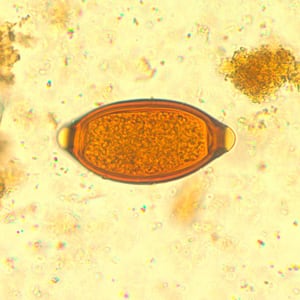It is a helminth also known as whipworm Trichuris trichiura. Infection is acquired by ingesting eggs from contaminated food, water or hands. In the USA, cases are seen in southern states. Adult worms live in the colon. People can get light or heavy infections. Light type is typically asymptomatic while heavy infection presents with frequent, painful passage of stool that contains a mixture of mucus, water, and blood. Rectal prolapse can also occur. Heavy infection in children can lead to severe anemia, growth retardation, and impaired cognitive development. Diagnosis is done by identification of eggs in stool samples following concentration methods. Eggs are barrel shaped with projecting mucus plugs at both ends. Sometimes, adult worms can be seen in the stool.
